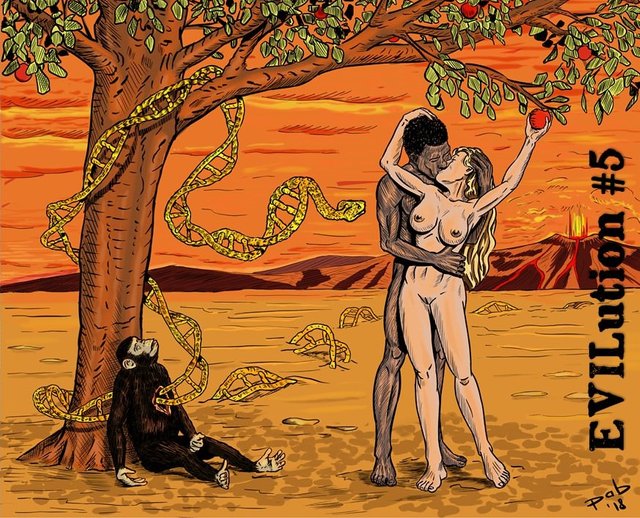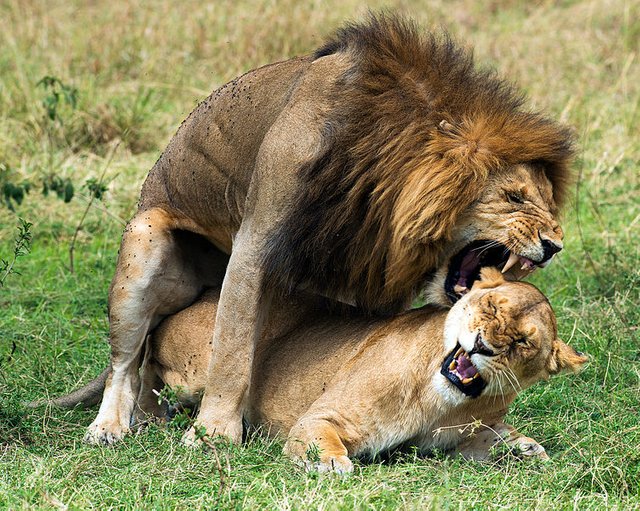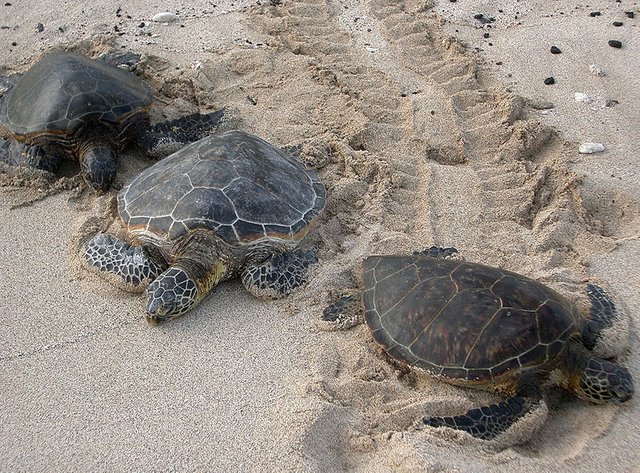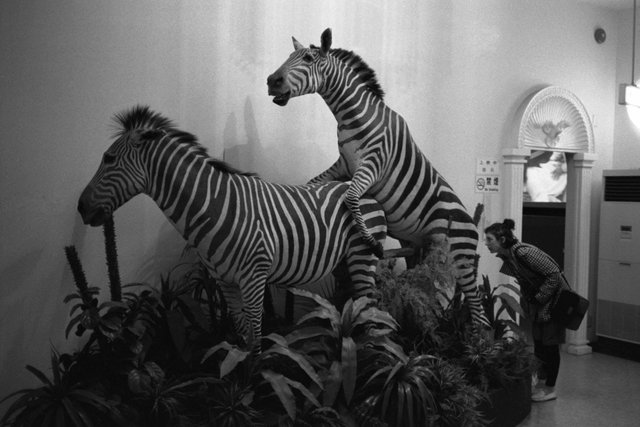Lately, especially in Italy, the issue of abortion is returning to be talked about because of the questioning of the law 194, which regulates the rules for the social protection of motherhood and the voluntary interruption of pregnancy.
In the capital, billboards were even posted in which the following sentence is quoted: "abortion is the leading cause of femicide in the world"; questionable affirmation under different points of view.

Attribution-ShareAlike CC BY-SA by @pab.ink thanks to @spaghettiscience and @davinci.art - Source
As always, this post does not intend in any way to express a judgment on the positions for or against abortion, which is certainly a complex issue and not easily distracted from an ethical-moral point of view; but, through examples stolen from nature, we want to show that some arguments normally used to prohibit abortion are based on false truths awkwardly disguised.
A safe discussion
The first element to be clarified is that of the level of the discussion: when someone claims to be against or in favour of abortion because his own reasoning requires him to consider an embryo or a fetus, as a potentially sentient living being to recognize the validity of the arguments: no matter what the position is expressed, it is important, instead, that the arguments have a solid and possibly common basis, like science. From this premise it is possible to establish a healthy discussion, because the premises are common.
Less acceptable, but still possible and understandable, is the attempt to base the discussion on religious assumptions. Our society, in fact, is composed of people with different beliefs, it is not correct to deal with such a topic starting from premises that only one of the parties can consider valid.
The last possibility, the only absolutely wrong and not tolerable, is to go into the debate moving from completely false premises. Some try to motivate their anti-abortion position through statements that sound more or less like this: abortion is something against nature, and therefore it should be prohibited. This sentence is not only profoundly hypocritical, as our society clearly also includes many other elements that would not be natural in this context, some of which make us human, but it is even a big lie. Before supporting such a thesis, in fact, it would be good to read about it; we should analyse all known species and verify if, in them, abortion (considering only the "voluntary" abortions by the mother or because of a male, and not the spontaneous abortions) occurs or not.
For obvious reasons this task is very difficult, and to restrict the field we will limit ourselves to analysing vertebrates and in particular mammals, a group to which man belongs.
Abortion in nature
During the search for abortion cases in the animal kingdom, with particular attention to the chordate phylum, we came across many descriptions of abortions due to fetal problems or complications of childbirth. These cases, however, are of little interest, as there is no "voluntariness" on the part of the mother (or father, affirmation that we will go further) and are therefore similar to spontaneous abortions that, as such, are not the subject of ethical discussion).
However, we have also identified some very close cases of abortions that can in some way challenge the "counter-nature" thesis. In fact, there are several animals in which the females, under certain conditions, put in place specific behaviors in order to interrupt the pregnancy, reabsorbing the embryos or holding the eggs not finding suitable environments for the deposition. Even more extreme is the case in which the male, during the coupling with an already pregnant female, can expel the fetus from the maternal uterus to allow the fertilization of a new egg with its own seed.
Obviously, we will take as an example only one species for each type of behavior similar to abortion that we have identified. In particular, as regards the reabsorption of embryos we will talk about the lion, on the lack of deposition caused by external factors we will analyze the behavior of sea turtles and finally we will try to understand the evolution of the zebra's penis able to expel the sperm from the uterus. the embryos from the female with which it will be coupled.
In lions
In order to fully understand why evolution has encouraged behaviors that tend, to a superficial and inattentive analysis, to lower the fitness of those who perpetrate them, it is necessary to analyze the dynamics that regulate the life of these animals. In fact, without knowing the biology and ethology of the lion it is impossible to understand what the advantage of the embryonal reabsorption by the lioness is.

Image CC BY 2.0 – Source
The male lions tend to protect a harem of females with which they mate and thanks to which a large number of offspring are guaranteed.
Once the puppies are born, if the dominant lion is defeated and removed from a rival, the latter will tend to kill all the kittens present in the flock in order to allow the lionesses to return to heat and be ready again to mate.
But what if the moment when the dominant lion is defeated coincides with the gestation of the females (which are often synchronized with each other)?
If the gestation is not too advanced, there is a reabsorption process that consists in the abortion of the embryo that ceases to develop and is reabsorbed by the mother. Analyzing the behavior of the male lion that kills all the puppies of the defeated rival should not be surprising that the lionesses have evolved a strategy not to disperse forces unnecessarily. In fact, carrying out a pregnancy is a simple task that requires a lot of energy without considering that in nature, childbirth is not a risk-free act for the mother. Therefore, natural selection has favored the onset of embryonic reabsorption, when the dominant lion is defeated, because pregnancy, if carried out, would result in a risk for the mother and the almost certain death of the children by the lion who takes over the harem.
In turtles
As far as concern turtles, talking about abortion is more complex, as they are oviparous animals, and therefore extremely different from us in the development of gestation and birth (ovodeposition). However, it is interesting to note at least a similarity with what happens in humans (and more generally in mammals).

Image CC0 Creative Commons – Source
Many species of sea turtle spawn in the same place they came into the world. The mechanism underlying this behaviour is not yet clear, but through studies, censuses and an ingenious marking system it has been possible to detect this peculiar trait. Some species, however, due to the anthropization of some stretches of the coasts, seem to respond to this stimulus (give birth where you are born) with a particular behaviour: if they do not find the beach where they were born, due to the construction of hotels and facilities of each type, or if for some reason they are disturbed, they prefer to keep the eggs inside them and not deliver them, rather than do it in areas adjacent to the place of origin. Although this is not similar to abortion in the strict sense, it is interesting to underline how the mother decides even in this case, "voluntarily" not to complete the procreative act. The fate of the eggs that are not deposited is still unclear, the plausible hypotheses are two: either the eggs are reabsorbed by the mother or they manage to survive in the maternal body and they are deposited later (more reliable hypothesis)
The explanation of this behaviour is still unclear but could be attributed to a too fast disappearance of the turtle breeding environments that have not had time to evolve new strategies to cope with this sudden change (even the rise in temperatures could play a fundamental role). The condition of stress and disorientation that comes from not finding the right place could cause the turtles not to lay down. It cannot be excluded that at the base of this behaviour there may be genetic constraints that do not allow an evolution in response to this stimulus.
In zebras
The zebra represents a truly fascinating case of real abortion, although it may rightfully be baffled.
The concept of departure is very similar to that of the lion, and even in this case we can identify a male who holds a harem of females with whom he has the right to mate. It can occur in large herds of zebras that a male "subtracts" a female (also pregnant) to its rightful owner, sometimes without the consent of the latter. The behavioral dynamics with which the "theft" is implemented are unclear, while the subsequent phases have been observed in detail.
The new male begins to persistently mate with the pregnant female, and this leads to possible outcomes:
- The embryo is still in the early stages of gestation, and is reabsorbed by the mother through a hormonal control activated by the sexual constraint implemented by the male;
- The embryo is in an intermediate phase of gestation, and this allows the male, through his sucker-shaped penis (structure probably evolved precisely for this purpose), to exert such force on the embryo to cause its detachment from the wall uterine of the mother;
- The embryo is now in an advanced stage and therefore the structure of the male's penis is not able to provoke detachment from the uterine wall. In this case the pregnancy is completed but the male will try to kill the baby at birth by kicking.

Image CC0 Creative Commons – Source
These three possible destinies are very interesting from an evolutionary point of view; the first and third are comparable to what happens in the lion, while the second is unique and very particular. In fact, in this case it is not possible to identify a "voluntariness" by the mother in interrupting the pregnancy, but it is a real violence on the part of the male. This case, however far from abortion intended in a human sense, facilitates the understanding (even more so than turtles) of a totally amoral dimension of nature and allows us to make a strong statement about abortion itself: not only this it exists in nature (and this would already be enough to make the hypothesis of its innaturality false), but besides being present, it manifests itself with a plasticity of surprising shapes, some of these able to leave us literally breathless for the mechanisms totally devoid of a sense of justice that we humans, mistakenly, try to attribute to nature.
Conclusions
That abortion is a phenomenon present in nature, under very different forms, is now a fact, and hardly anyone can be able to support the opposite; this, in any case, does not necessarily make it correct from an ethical (and human) point of view. In fact, nature provides no indication of what is ethically correct and morally appreciable.
Precisely for this reason, as we have already stressed in the first lines, it is not our interest or purpose to give this article a definitive judgment on abortion.
On the contrary, the purpose of this post is to stimulate a discussion that can be healthy, not only on Steemit, but also outside, which starts from common and shared assumptions; the ideas and positions of each must always be respected and accepted, but for this to be possible, the debate must move its steps from true premises; and in this perspective, affirmations like that of "counter-nature" must absolutely be denied and removed.

EVILution #5 - L'innaturale naturalezza dell'aborto
Ultimamente, soprattutto in Italia, il tema dell’aborto sta tornando a far parlare di sé a causa della rimessa in discussione della legge 194, che regola le norme per la tutela sociale della maternità e sull'interruzione volontaria della gravidanza.
Nella capitale sono stati addirittura affissi dei cartelloni pubblicitari nei quali è riportata la seguente frase: “l’aborto è la prima causa di femminicidio nel mondo”; affermazione discutibile sotto diversi punti di vista.

Attribution-ShareAlike CC BY-SA by @pab.ink thanks to @spaghettiscience and @davinci.art - Source
Come sempre, con questo post non si intende in alcun modo esprimere un giudizio sulle posizioni pro o contro l’aborto, che rappresenta sicuramente un tema complesso e non facilmente districabile da un punto di vista etico-morale; bensì, attraverso esempi rubati alla natura, si vuole dimostrare che alcuni argomenti normalmente utilizzati per proibire l’aborto si basano su false verità goffamente mascherate.
Una discussione sana
Il primo elemento da chiarire è quello del livello della discussione: quando qualcuno sostiene di essere contro o a favore dell’aborto perché il proprio raziocinio gli impone di considerare o meno un embrione, o un feto, come essere vivente potenzialmente senziente bisogna riconoscere la validità delle argomentazioni: non importa quale sia la posizione espressa, è importante, invece, che le argomentazioni abbiano una base solida e possibilmente comune, come la scienza. Da questa premessa è possibile istituire una discussione sana, perché le premesse sono comuni.
Meno accettabile, ma comunque possibile e comprensibile, è il tentativo di basare la discussione su assunti religiosi. La nostra società, infatti, è composta da persone con credenze diverse, è non è corretto affrontare un argomento del genere partendo da premesse che solo una delle parti può ritenere valide.
L’ultima possibilità, l’unica assolutamente sbagliata e non tollerabile, è quella di addentrarsi nel dibattito muovendo da premesse completamente false. Alcuni provano infatti a motivare la propria posizione anti-aborto attraverso affermazioni che suonano più o meno così: l’aborto è qualcosa contro natura, e quindi va proibito. Questa frase non solo è profondamente ipocrita, in quanto la nostra società comprende chiaramente anche molti altri elementi che in quest’ottica risulterebbero non naturali, alcuni dei quali ci rendono umani, ma è addirittura una grande bugia. Prima di sostenere una tesi del genere, infatti, sarebbe bene documentarsi a riguardo; bisognerebbe analizzare tutte le specie conosciute e verificare se, in esse, l’aborto (considerando solo gli aborti “volontari” da parte della madre o a causa di un maschio, e non quelli spontanei) si verifichi o meno.
Per ovvie ragioni questo compito è molto arduo, e per restringere il campo ci limiteremo ad analizzare i vertebrati ed in particolare i mammiferi, gruppo a cui l’uomo appartiene.
L’aborto in natura
Durante la ricerca di casi di aborto nel regno animale, con particolare attenzione al phylum dei cordati, ci siamo imbattuti in molte descrizioni di aborti dovuti a problemi del feto oppure a complicanze del parto. Questi casi risultano però di poco interesse, in quanto non è presente alcuna “volontarietà” da parte della madre (o del padre, affermazione che approfondiremo più avanti) e sono pertanto assimilabili ad aborti spontanei che, come tali, non risultano essere oggetto di discussioni etiche).
Abbiamo però identificato anche alcuni casi, a noi molto vicini, di aborti che possono in qualche modo mettere in discussione la tesi del “contro natura”. Esistono infatti diversi animali in cui le femmine, in determinate condizioni, mettono in atto comportamenti specifici al fine di interrompere la gravidanza, riassorbendo gli embrioni o trattenendo le uova non trovando ambienti adatti alla deposizione. Ancora più estremo è il caso in cui il maschio, durante l’accoppiamento con una femmina già gravida, può far espellere il feto dall’utero materno per consentire la fecondazione di un nuovo ovulo con il proprio seme.
Ovviamente prenderemo come esempio solo una specie per ogni tipologia di comportamento assimilabile all’aborto che abbiamo identificato. In particolare, per quanto riguarda il riassorbimento degli embrioni parleremo del leone, sulla mancata deposizione causata da fattori esterni analizzeremo il comportamento delle tartarughe marine ed infine cercheremo di comprendere l’evoluzione del pene della zebra in grado di far espellere dall’utero lo sperma e gli embrioni dalla femmina con cui si andrà ad accoppiare.
Nei leoni
Per poter comprendere a pieno il perché l’evoluzione abbia favorito dei comportamenti che tendono, ad una analisi superficiale e disattenta, ad abbassare la fitness di chi li perpetra è necessario analizzare le dinamiche che regolano la vita di questi animali. Infatti, senza conoscere biologia ed etologia del leone è impossibile comprendere quale sia il vantaggio del riassorbimento embrionale da parte della leonessa.

Image CC BY 2.0 – Source
I leoni maschi tendono a proteggere un harem di femmine con cui si accoppiano e grazie alle quali si garantiscono una prole numerosa.
Una volta nati i cuccioli, se il leone dominante viene sconfitto ed allontanato da un rivale, quest’ultimo tenderà ad uccidere tutti i cuccioli presenti nel branco in modo da consentire alle leonesse di rientrare in calore ed essere pronte nuovamente all’accoppiamento.
Ma cosa succede se il momento in cui il leone dominante viene sconfitto coincide con la gestazione delle femmine (che spesso sono sincronizzate tra loro)?
Se la gestazione non è troppo avanzata avviene un processo di riassorbimento che consiste nell’aborto dell’embrione che cessa di svilupparsi e viene riassorbito dalla madre. Analizzando il comportamento del leone maschio che uccide tutti i cuccioli del rivale sconfitto non dovrebbe sorprendere che le leonesse abbiano evoluto una strategia per non disperdere forze inutilmente. Infatti, portare a termine una gravidanza è un compito non semplice che richiede tantissime energie senza considerare che in natura il parto non è un atto privo di rischi per la madre. Quindi la selezione naturale ha favorito l’insorgenza del riassorbimento embrionale, nel momento in cui il leone dominante viene sconfitto, in quanto la gravidanza se portata a termine comporterebbe un rischio per la madre e la morte quasi sicura dei figli da parte del leone che subentra nell’harem.
Nelle tartarughe
Per quanto riguarda le tartarughe, parlare di aborto è più complesso, in quanto si tratta di animali ovipari, e quindi estremamente differenti da noi nello sviluppo di gestazione e parto (più precisamente ovodeposizione). Resta però interessante notare quantomeno una similitudine con ciò che accade nell’uomo (e più in generale nei mammiferi).

Image CC0 Creative Commons – Source
Molte specie di tartaruga marina depongono le uova nello stesso posto in cui sono venute al mondo. Non è ancora chiaro il meccanismo alla base di questo comportamento, ma attraverso studi, censimenti ed un ingegnoso sistema di marcatura è stato possibile rilevare questo tratto peculiare. Alcune specie però, a causa dell’antropizzazione di alcuni tratti dei litorali, sembrano rispondere a questo stimolo (partorire dove si nasce) con un comportamento particolare: se non ritrovano la spiaggia dove sono nati, a causa della costruzione di alberghi e strutture di ogni tipo, o se per qualche ragione vengono disturbate, scelgono di trattenere le uova al loro interno e di non ovodeporre, piuttosto che farlo in zone limitrofe al luogo di provenienza. Nonostante questo non sia assimilabile ad un aborto in senso stretto, è interessante sottolineare come la madre decida anche in questo caso, “volontariamente” di non portare a termine l’atto procreativo. La ritenzione delle uova, infatti, compromette in molti casi lo sviluppo degli embrioni e, talvolta, mette in pericolo la vita stessa della madre. Tutt’ora è ancora poco chiaro il destino delle uova che non vengono deposto, le ipotesi plausibili sono due: o le uova vengono riassorbite dalla madre oppure riescono a sopravvivere a nel corpo materno e vengono deposto in seguito (ipotesi più accreditata)
La spiegazione di questo comportamento è ancora poco chiara, ma potrebbe essere attribuita ad una scomparsa troppo veloce degli ambienti di riproduzione delle tartarughe che non hanno avuto il tempo di evolvere nuove strategie per fronteggiare questo cambiamento repentino (anche l’innalzamento delle temperature potrebbe giocare un ruolo fondamentale). La condizione di stress e di disorientamento che deriva dal non ritrovare il luogo adatto potrebbe indurre le tartarughe a non deporre. Non è da escludere che alla base di questo comportamento ci possano essere dei vincoli genetici che non consentono un’evoluzione in risposta a questo stimolo.
Nelle zebre
La zebra rappresenta un caso veramente affascinante di vero e proprio aborto, nonostante possa giustamente lasciarsi interdetti.
Il concetto di partenza è molto simile a quello del leone, e anche in questo caso possiamo identificare un maschio che detiene un harem di femmine con cui ha il diritto di accoppiarsi. Può verificarsi nei grossi branchi di zebre che un maschio “sottragga” una femmina (anche gravida) al legittimo proprietario, talvolta senza il consenso di quest’ultima. Le dinamiche comportamentali con cui il “furto” viene attuato sono poco chiare, mentre le fasi successive sono state osservate nel dettaglio.
Il nuovo maschio comincia ad accoppiare insistentemente con la femmina gravida, e questo porta a tra possibili esiti:
- L’embrione è ancora nelle prime fasi di gestazione, e viene riassorbito dalla madre attraverso un controllo ormonale attivato dalla costrizione sessuale messa in atto dal maschio;
- L’embrione è in una fase intermedia della gestazione, e questo consente al maschio, attraverso il suo pene a forma di ventosa (struttura evoluta probabilmente proprio a questo scopo), di esercitare una forza tale sull’embrione da causarne il distaccamento dalla parete uterina della madre;
- L’embrione è ormai in uno stadio avanzato e quindi la struttura del pene del maschio non è in grado di provocare il distaccamento dalla parete uterini. In questo caso la gravidanza viene portata a termine ma il maschio tenterà di uccidere il neonato alla nascita scalciando.

Image CC0 Creative Commons – Source
Questi tre possibili destini sono molto interessanti dal punto di vista evoluzionistico; il primo ed il terzo sono paragonabili a quello che avviene nel leone, mentre il secondo è unico e molto particolare. Infatti, in questo caso non è possibile identificare una “volontarietà” da parte della madre nell’interrompere la gravidanza, ma si tratta di una vera e propria violenza da parte del maschio. Questo caso, per quanto si discosti dall’aborto inteso in senso umano, ci facilita la comprensione (ancor più delle tartarughe) di una dimensione totalmente amorale della natura e ci consente di fare un’affermazione forte riguardo l’aborto stesso: non solo questo esiste in natura (e questo sarebbe già sufficiente per rendere falsa l’ipotesi della sua innaturalità), ma oltre ad essere presente, si manifesta con una plasticità di forme sorprendente, alcune di queste in grado di lasciarci letteralmente senza fiato per i meccanismi totalmente privi di un senso di giustizia che noi umani, sbagliando, cerchiamo di attribuire alla natura.
Conclusioni
Che l’aborto sia un fenomeno presente in natura, sotto forme molto differenti, ormai è un dato di fatto, e difficilmente qualcuno può essere in grado di sostenere il contrario; questo, in ogni caso, non lo rende necessariamente corretto da un punto di vista etico (e umano). Infatti, la natura non ci fornice indicazione alcuna su ciò che è eticamente corretto e moralmente apprezzabile.
Proprio per questo, come abbiamo già sottolineato nelle prime righe, non è nostro interesse o fine dare in questo articolo un giudizio definitivo sull’aborto.
Al contrario, lo scopo di questo post è quello di stimolare una discussione che possa essere sana, non solo su Steemit, ma anche al di fuori, che parta da presupposti comuni e condivisibili; le idee e le posizioni di ciascuno devono essere sempre rispettate e accettate, ma perché questo sia possibile è necessario che il dibattito muove i suoi passi da premesse vere; e in questa ottica, affermazioni come quella del “contro natura” devono assolutamente essere smentite e rimosse.

Immagine CC0 Creative Commons, si ringrazia @mrazura per il logo ITASTEM.
CLICK HERE AND VOTE FOR DAVINCI.WITNESS
References
- Brian C. R. Bertram (1975). Social factors influencing reproduction in wild lions.
https://doi.org/10.1111/j.1469-7998.1975.tb02246.x - Michael E. Pereira (1983). Abortion following the immigration of an adult male baboon (Papio cynocephalus).
https://doi.org/10.1002/ajp.1350040109 - Sea Turtle Conservation Program
- Davide Bomben. Animali Africani.

Logo creato da @ilvacca
Awesome idea for an article. I never knew Zebra sex could be so violent/weird/extreme. The bit about lionesses absorbing a fetus when another lion takes over is also a cool piece of info.
Downvoting a post can decrease pending rewards and make it less visible. Common reasons:
Submit
You were right when you mentioned that the issue of abortion
In trurh, it is not one that can be outrightly banned nor one that would be without regulation. And as for the examples you have brought foward in animals, i am completely overwhelmed.
Good job!
Downvoting a post can decrease pending rewards and make it less visible. Common reasons:
Submit
We could like it or not, but some kind of regulation is necessary. How to reach a regulation as correct as possible? I do not know. The important thing is that the discussions are done honestly...
Thank you for your comment!
Downvoting a post can decrease pending rewards and make it less visible. Common reasons:
Submit
Hello @spaghettiscience
Quite a controversial topic. But I am happy that you realized this early enough and avoided taking sides with any particular school of thought.
Knowing that abortion can also occur in other animals is among the many things I learn in this article.
Regards @eurogee of @euronation and @steemstem communities
No
Downvoting a post can decrease pending rewards and make it less visible. Common reasons:
Submit
Hello @eurogee!
As you can imagine I also have my own opinion about abortion, but I firmly believe that if you want to start a discussion on any topic it is important to do so from a point of view as objective as possible, setting aside (at least for a moment) personal beliefs and listening to what others have to say.
Downvoting a post can decrease pending rewards and make it less visible. Common reasons:
Submit
Exactly! ✌️✌️
Downvoting a post can decrease pending rewards and make it less visible. Common reasons:
Submit
He didn't read this. just the top.
Downvoting a post can decrease pending rewards and make it less visible. Common reasons:
Submit
The leading cause of death is faunication. We should definitely outlaw all sex! And while rallying against anything that is "against nature" we should definitely withhold all medical treatment, all man made safety equipment, devices, and fruits of technology from those that peddle these ideas. Let them crawl back to the caves from whence they came!
Downvoting a post can decrease pending rewards and make it less visible. Common reasons:
Submit
I think it becomes clear that abortion is not a “nature” or necessarily a “science” discussion. Like many other issues this is based on someone’s personal views, which are based on someone’s background. And like every subjective discussion there can not be an objective, but rather a majority solution. There are pros and cons on either side, but many of these rely on fundamental values of different world views. Thank you for bringing up this controversial topic. Cheers!
Downvoting a post can decrease pending rewards and make it less visible. Common reasons:
Submit
It can never be a merely scientific discussion... But science must find, with humility, the way to help those who must "regulate".
Downvoting a post can decrease pending rewards and make it less visible. Common reasons:
Submit
Damn this was exciting to read! I mean, i always knew that whenever a new male Lion takes over a pride it kills the cubs of the former predominant male. But ididn't think it was for that purpose -to get to mate with the female and raise his own family-. After all, who wouldn't want their kids around them instead?. There's an enzyme for everything these days. By reabsorption of the embryo by female lions, I suppose a killer-enzyme act on the embryo and slowly boycotts the growth process. are there implications?
However, verbal consent or not, i didn't think the act of abortion spread out into the animal kingdom as well. Which is really intriguing. The Zebra really is a wonder at what it does. They look so cool in their herds, wouldn't imagine them owning harems, talk more of kicking a young that isn't theirs.
Excellent article here buddy.
Downvoting a post can decrease pending rewards and make it less visible. Common reasons:
Submit
Thank you @pangoli!
About killer-enzymes... I do not know specific research about lions, but many experiments have been done on mice, in which something similar happens. It seems that when a male disappears, the absence of its smell triggers a signaling cascade that leads to the activation of some pathways that cause abortion ... So, ultimately, yes... Everything is probably regulated by some enzymes.
And about infanticide, however, it is surprising to know that what zebras and lions do is not too different from what humans do still today. Some research has shown that in our society the majority (almost all) of infanticide is committed by adoptive parents who take over the family... Despite the many social conditioning, it seems that we still keep many animal instincts ...
Downvoting a post can decrease pending rewards and make it less visible. Common reasons:
Submit
Enzymes it is.
True that buddy. the animal instincts are only but relegated, regardless it's still there. And with countries like the US paying foster parents for keeping 'special needs children', it's probably a lot more about the money than it is about the kids. Most cases come from adoptive parents.
Downvoting a post can decrease pending rewards and make it less visible. Common reasons:
Submit
This post has been voted on by the steemstem curation team and voting trail.
There is more to SteemSTEM than just writing posts, check here for some more tips on being a community member. You can also join our discord here to get to know the rest of the community!
Downvoting a post can decrease pending rewards and make it less visible. Common reasons:
Submit